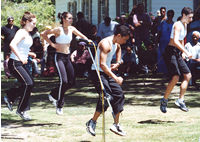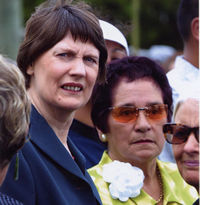|
The months leading
up to 6 February 1995 were marked by increasing tensions on treaty
issues, even before the government released its long-awaited new
proposals for the settlement of Treaty claims in December 1994.
These brought a negative response from all levels of the Maori community
and placed the events at Waitangi in jeopardy. Protest was expected,
but its nature and extent caught many
people off-guard.

Events on Te Tii marae led to the cancellation
of the forum, and with protest flags hoisted on the treaty house
grounds and public security uncertain, the formal ceremonies were
cancelled. The images transmitted by the media conveyed powerful
messages to the nation.Within days Prime Minister
Jim Bolger used his annual state of the nation address to comment
on race relations: 'What happened at Waitangi is not the universal
face of Maoridom and must not be seen as such', he said. 'Equally,
what happened at Waitangi means there can be no going back to
commemorate and celebrate Waitangi as it was. That is over.' The
public was invited to comment and propose alternatives, but in
the end the government, like Labour in the 1980s, decided on a
strategic repositioning of events.
Beyond
1995
From 1996 to 1998
the official ceremonies were held at Government House in Wellington,
and a function at Waitangi had a limited government presence. In
1998 Prime Minister Jenny Shipley attended the dawn ceremony at
Waitangi, before returning to Wellington for the official commemorations.
In that year opposition leader Helen Clark was challenged about
her right as a woman to speak on the Te Tii marae. Despite this
incident there were few protests and no arrests, with the New
Zealand Herald describing it as 'the most peaceful Waitangi
Day in years'.In 1999 the Crown returned
to Waitangi and both the Prime Minister and the Governor-General
attended the official commemorations. The day was once more a largely
peaceful affair, though some protesters labelled the programme
a sham.
'It is my strong
belief that the days and events around Waitangi Day should contribute
to the building of a sense of New Zealand identity and purpose.'
The Prime Minister, the Rt Hon Helen Clark, The
Dominion, 21 January 2000 |
In 2000 the official
ceremonies were again held at Waitangi, but the new Labour Prime
Minister, Helen Clark, decided to attend a Waitangi Day function
at Onuku marae, Akaroa. The
Governor General, Sir Michael Hardie Boys, a group of MPs and Jenny
Shipley, now leader of the Opposition were at Waitangi.

Aerobics
group at Waitangi, 2000
The programme of events
on the treaty house grounds aimed to make the day one of spiritual
observance, ceremony, family fun and entertainment. It was generally
successful. But an official welcome and forum at Te Tii marae
did not run smoothly and there was an assault on the Waitangi
flagpole in the early hours of 6 February. Most media reports
focused on these aspects and gave brief coverage to the rest.
Cabinet decided that in 2001 there would be no official representation
there, but in the end two cabinet ministers were present. The
Waitangi National Trust Board, responsible for the treaty house
and grounds, organised events to mark the day including a church
service. Although this was disrupted by 300 young people, the
rest of the day passed peacefully with games and waka events.
The Prime Minister attended functions in Auckland and Wellington;
and the Deputy Prime Minister participated in a marae event in
the Hutt Valley, joined by the Governor General who also had
a function at Government House. The difficulties associated with
events at Waitangi and at Te Tii marae over the years have raised
questions about whether official commemorations should continue
to be held at Waitangi. In 2002, however, the Crown returned
to Waitangi with the Governor General, Dame Silvia Cartwright,
the Attorney General, Chief Judge Sian Elias, and the Prime Minister,
the Rt Hon Helen Clark.

Prime
Minister, Helen Clark, with her escort Titewhai Harawira, 2002.
A large body of Government and Opposition members as well as
other guests attended. Tensions were not absent from proceedings.
Protestors disturbed the welcome at Te Tii and an early church
service in the Whare Runanga on the treaty house grounds
but events during the rest of the day were held in a celebratory
atmosphere. Moves to commemorate Waitangi Day elsewhere in
New Zealand have expanded. In 2001 and 2002 a number of functions
and events were held, some of them assisted by funding which
for some five years had been available through the Department
of Internal Affairs. In 2001 responsibility for administering
this fund was taken over by the Ministry for Culture and
Heritage. The Commemorating
Waitangi Day Fund supports activities that acknowledge
the signing of the treaty. Applications for funding are assessed
on the basis of criteria such as encouraging community participation
and achievement, promoting a cultural experience and event,
and providing participants with an opportunity to learn more
about the treaty. The fund has supported dozens of events
around the country, ranging from a commemoration of Lieutenant
-Governor William Hobson's journey from the Bay of Islands
to Mangungu, where the Hokianga signing of the treaty was
held, to community tree planting, hangi and kapa haka performance
on the West Coast. Events supported by the fund celebrate
the positive aspects of Waitangi Day - the coming together
of the peoples of New Zealand in a treaty partnership.

The
Nga Puhi waka taua (war canoe) Ngatokimatawhaorua
While
6 February is recognised as New Zealand's national day,
the long-standing tensions associated with the day are always
likely to surface in one form of another. The date is
an important marker in the country's history, however, and
recognition of the treaty's significance as the foundation
document of the nation will continue to encourage leaders, communities
and individuals to mark the day in new ways. |
![]() Gallery
Gallery ![]() Waitangi
Day
Waitangi
Day